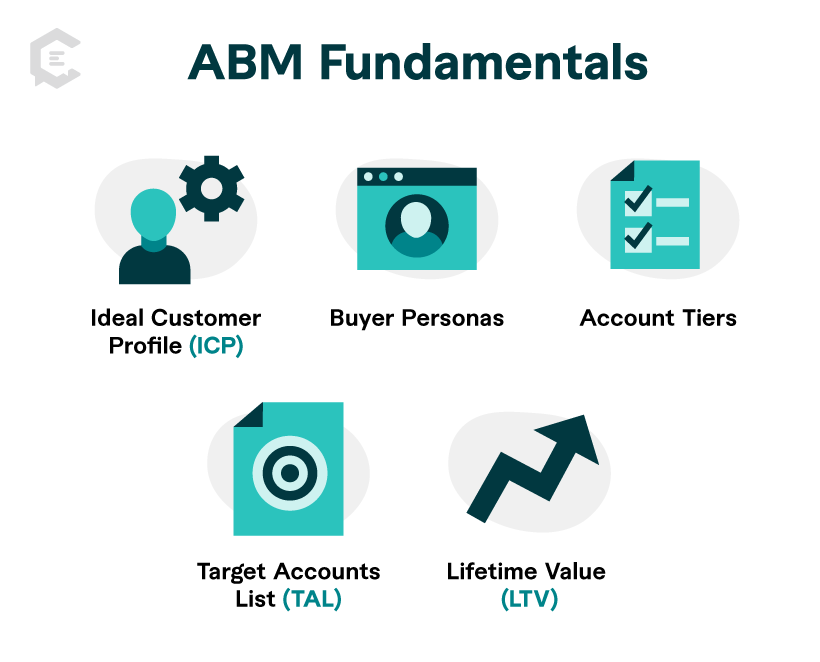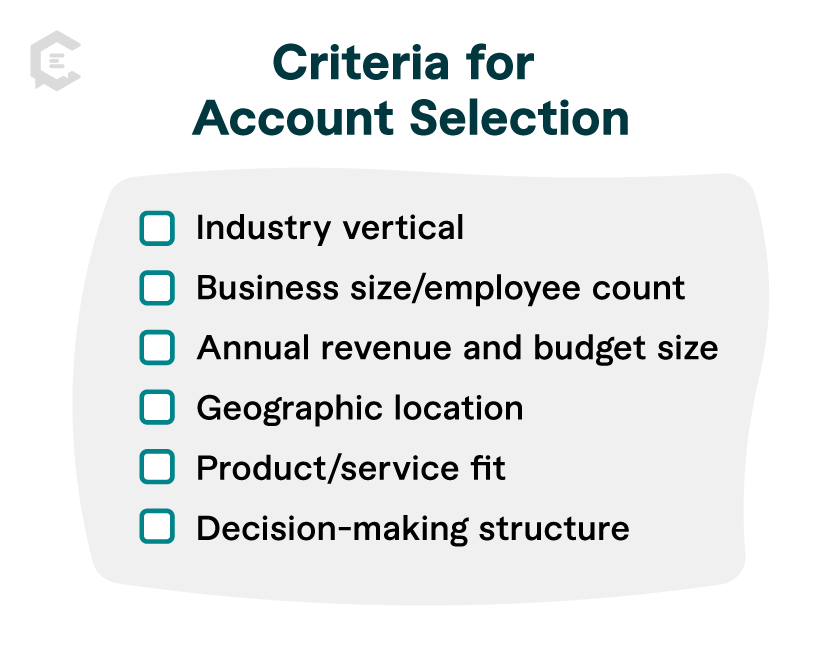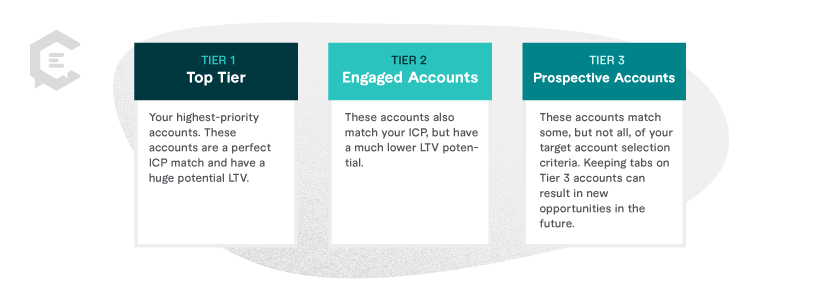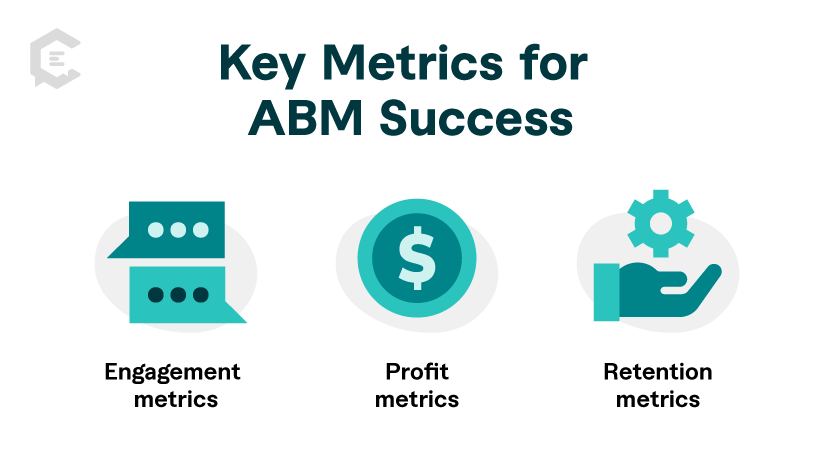Account-Based Marketing, or ABM, is a specialized strategy that targets high-value prospects. The aim is to focus your marketing and sales teams’ resources on closing your most profitable accounts, wielding hyper-personalized content and interactions to boost revenue.
However, running ABM campaigns isn’t a walk in the park.
To develop compelling, personalized buying experiences, you need a strategic approach.
Apart from identifying the right target accounts, you should also use the ideal content types, track the right metrics, and implement the best techniques by unifying your sales and marketing teams.

Understanding ABM Fundamentals
Throughout this guide, we’ll cover important concepts within an ABM strategy, such as:
- Ideal Customer Profile (ICP). A detailed description of what defines your target account
- Buyer Personas. A fictional representation of prospects or, in an ABM sense, the individuals within your ICPs
- Account Tiers. The segmentation and prioritization of target accounts in ABM based on potential sales revenue.
- Target Accounts List (TAL). The list of potential companies or customers to target in your ABM campaign
- Lifetime Value (LTV). The amount of revenue you expect to earn from a target account
Setting Clear Objectives and Goals
The end goal of any ABM strategy is to close everyone in your TAL. However, it’s also important to define specific objectives throughout your campaign.
Setting clear campaign objectives will help bring your marketing and sales teams together.
This will also help you benchmark the effectiveness and performance of your ABM strategies, allowing you to make data-driven adjustments along the way.
Ask yourself the following questions to set specific objectives for ABM:
- What is your revenue goal in your ABM campaign?
- How many target accounts do you need to reach?
- What LTV do you expect from your target accounts?
- What engagement rate per content channel will help you reach your revenue goal?
- What is your target conversion rate per account?
- Will you achieve a positive ROI with your current ABM campaign strategies?
Identifying and Selecting Target Accounts
Defining revenue targets in your ABM campaign will help you select your target accounts.
This part of ABM usually entails two phases: setting your criteria for account selection and measuring data for account qualification.
Criteria for account selection
Your account selection criteria should include your ideal target accounts’ unique and measurable characteristics. These qualities will be consolidated into your ICP for a seamless qualification process.
Here are some criteria examples to get you started:
- Industry vertical
- Business size/employee count
- Annual revenue and budget size
- Geographic location
- Product/service fit
- Decision-making structure
If you want target accounts with higher chances of conversion, consider adding previous interactions and buying signals to your checklist. This includes webinar attendance, consultation bookings, content downloads, and direct inquiries.
You should also establish multiple target account tiers that decide your engagement tactics and content strategy based on these signals. See “Engagement Tactics and Techniques” below for more details.
Utilizing data and analytics in account selection
After establishing your criteria for account selection, it’s time to crunch the numbers and evaluate prospects to see if they’re a good match for your ABM campaign.
Customer data can come from multiple sources. Their CRM platform should contain dozens of potential target accounts for large and established businesses ripe for their ABM advances.
Aside from your CRM platform, you can use the following data sources to pluck out potential target accounts:
- Website audience analytics
- Social media reports
- Third-party B2B lead providers
- Customer survey and feedback data
- Internal sales data (lookalike customers)
Aligning Sales and Marketing Teams
With your goals and ICP all set, you’re ready to assemble a team to spearhead your ABM operations.
More importantly, you must equip them with tools and other resources to enhance collaboration, facilitate information sharing, and streamline reporting.
Creating a Unified ABM team
It’s crucial to pick members of your sales and marketing teams who are already familiar and experienced with handling high-value accounts.
This includes sales leaders, marketing leaders, content specialists, and internal champions who will deliver opportunities and prospects from target organizations.
Other key roles in an ABM team include:
- Operations manager
- Sales manager
- Sales director
- Marketing manager
- Graphic designers
- Copywriters
- Analytics specialists
- Salespeople
- Customer success manager
Communication and collaboration strategies for ABM
When keeping everyone on your ABM team on the same page, invest in tools and roll out strategies that enhance internal communication, collaboration, and feedback. For instance, a comprehensive solution like HubSpot ABM Software has everything you need to run successful ABM campaigns.
You may also explore other tools that enable instant and seamless collaboration, like Slack, Asana, Microsoft Teams, and Monday.com.
Developing Personalized Content and Campaigns
Building your ABM strategy and assembling your team is half the job. The next order of business is to develop a hyper-personalized content strategy tailored to target accounts.
Understanding the needs of target accounts
Your objective is to unveil each target account’s pain points, goals, and needs and then package a unique value proposition that addresses these aspects.
Look into the following to better understand your target accounts:
- What content topics and types did they engage with?
- What do they need to accomplish with your products/services?
- What challenges stand between them and their goals?
- How big is their buying power?
- Did they ask questions during engagements?
- Do they have experience with a competitor?
Answering these questions helps you create a unique value proposition that connects with target accounts more authentically and positively.
Strategies for creating personalized ABM content
Your next priority is personalization, which should permeate every decision, messaging, and interaction in your marketing and sales processes.
More specifically, hyper-personalization should be injected into your ABM content creation process.
This encompasses your website content, landing pages, social media interactions, retargeted ads, and sales offers.
- Landing page. Build dedicated landing pages and present your product or service as the ultimate solution to their problems. Seal the deal with personalized copy and Calls-to-Action (CTAs) directed at each target account.
- Content. Create content that moves them down the marketing or sales funnel. They should include relevant, actionable advice tailored to the target account’s current needs.
- Advertising. Your paid media should present an offer that’s specific to the target account’s tier. Other attributes like business size and industry vertical may also be used to decide the best advertising content.
- Social media campaigns. Use the platform and content format that your target prospects prefer. This may include short-form videos, articles, industry reports, infographics, etc.
- Emails. Personalized emails work best when reaching out to high-value target accounts. Go beyond automated personalization (first name, subject line, etc.) and refer to recent events, interactions, and trends to make your email more genuine.
Remember, you may need to create a ton of personalized content to accommodate the totality of your TAL. If you need extra manpower, hire expert content production services tailored to your ABM content goals.
Engagement tactics and techniques
A multi-channel approach to executing your ABM strategy is pivotal to creating a compelling experience for your target accounts.
The only question is, how much marketing and sales bandwidth should you allocate to each target account?
This is where account tiering comes into play.
For most ABM campaigns, a three-tier strategy works incredibly well:
- Tier 1 (Top Tier). Your highest-priority accounts. These accounts are a perfect ICP match and have a huge potential LTV
- Tier 2 (Engaged Accounts). These accounts also match your ICP, but have a much lower LTV potential
- Tier 3 (Prospective Accounts). These accounts match some, but not all, of your target account selection criteria. Keeping tabs on Tier 3 accounts can result in new opportunities in the future.
For Tier 1 accounts, leverage hyper-personalized activities like 1:1 interactions, direct social media interactions, and invitations to physical events.
If you host interviews or other digital events, consider inviting these top-tier accounts as guests.
Tier 2 accounts also deserve personalization, but not to the same extent as Tier 1 accounts.
You may design a dedicated landing page for this account group, engage them on social media, send regular newsletters, launch targeted ad campaigns, or all of the above.
Lastly, Tier 3 accounts can remain in your broader marketing funnel until they show signals of moving up a level.
Use inbound marketing methods like blogging, SEO, and social media marketing to nurture them into your ABM campaign.
Measuring and Analyzing ABM Performance
No ABM campaign is perfect. And it’s up to you to identify and fix the inefficiencies to maximize ROI.
Key metrics for ABM success
To gauge ABM performance, establish a tracking method for the following metrics:
- Engagement metrics. Social media engagement, email engagement, content downloads, and form submissions.
- Profit metrics. Conversion rate, average deal size, cross-sells, upsells, and revenue generated.
- Retention metrics. Customer Satisfaction Score (CSAT), Net Promoter Score (NPS), LTV, etc.
Your analytics specialist should be able to assist you in setting up the tracking and reporting tools you need. In most cases, analytics are included in essential ABM software, including CRM solutions and project management software.
Start Your ABM Campaign with Expert Content Today
Whether you’re new to ABM or looking for ways to improve your campaign, it’s important to build a solid content strategy that guarantees hyper-personalized experiences to prospects. That’s where ClearVoice comes in. Connect with an expert content strategist and create the perfect content plan for your ABM campaign.








